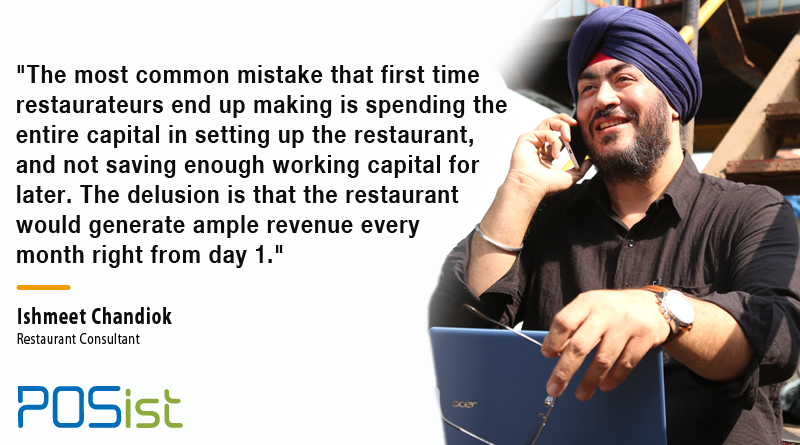As Chef and a Consultant, Ishmeet Chandoik has 17 years of experience and has a vast knowledge of kitchen operations, menu designing and restaurant management. Ishmeet is currently running his own brand Harley’s corner and also works as a Restaurant Consultant with Nitin Tandon Food & Styling. At present, he is mentoring few food start-ups and is helping more than 10 brands to scale up. In his experience, he has consulted various restaurants from pure vegetarian non-alcoholic restaurant to a restaurant which primarily serves grill food and alcohol.
Common Restaurant Management Mistakes Made by New Restaurateurs
In an exclusive interaction with The Restaurant Times, Ishmeet shared his insights on the mistakes that new restaurateurs usually make. According to him, mostly first-time restaurateurs are just entrepreneurs setting up another business. The main problem is usually nothing but a lack of foresightedness, which results in the business mistakes.
1. Miscalculated Financial Projections
The most common restaurant management mistakes that new restaurateurs end up making is spending the entire capital in setting up the restaurant, and not saving enough working capital for later. The delusion is that the restaurant would generate ample revenue every month right from day 1.
It is better to scale down the project and keep a healthy working capital that would last for 6-8 months at least. Also, the initial amount invested is quite huge, and a premature exit can lead to huge losses. It takes some time to reach the breakeven point; it is important to save working capital until then.
At times, restaurants may be expected to do well in the long term, but due to lack of capital, they often shut down within the first year of operations.
2. Overwhelming Concepts
Often restaurateurs get impressed by certain restaurants and try to replicate the same without giving much thought to their background. This is especially true for the theme restaurants or the food outlets that crop up to cater to a particular trend. Trends tend to come and go very quickly, and it becomes difficult to sustain operations when the trend dies out. Most of the chain restaurant think that after 3-4 years if they open another outlet, they can sustain the lifecycle by 7-8 years. But that’s not true.
It is important to think ahead of curve and find out what would trend in future. The average lifecycle of restaurants is 6-7 years before they overhaul or do some major. While for lounges and nightclub it lasts for four years. While for QSRs, it’s only about the product. If you bring out new stuff then only you’ll be in trend.
Thus arises the need to conduct a market research and study the demand for a particular area and the target audience before opening a restaurant. Also, execution of the concept is quite a challenge. It is essential that you have a detailed business plan before you set up your restaurant as it helps a lot in the implementation of the restaurant concept.
3. Out of Control Food Costs
The main reason that leads to escalated Food Cost is the lack of Standardization in the preparing process. Most restaurants struggle with inflated Food Costs. On paper, the projected Food Costs is usually estimated to be 22 percent, but at the end of the month it turns out to be as high as 44 percent. This is because restaurateurs forget the actual Product Yield while ordering raw ingredients for the inventory. Find out how to control the Food Costs in your restaurant here.
The average food cost should be between 28-32 percent for any restaurant. However, if the cuisine has certain high-value raw ingredients, it can go up to 45-50 percent because the base price is high of these items. The Food Cost for Indian cuisine should be around 28-30 percent. For Continental Cuisines, the Food Cost is 30-34 percent because of the high cost of sauces, butter, and cream. In the case of Indo-Chinese, the Food Cost can go as down as 22 percent if the Chef is really good. For vegetarian South Indian food, the cost is the least (18-20 percent) since you are using only pulses and rice. However, for non-vegetarian South Indian food, the Food Cost can go up to 30 percent.
4. Poor Menu Design & Engineering
While creating the menu, often restaurateurs focus on what they can serve easily and forget the technical part of it. The menu should be a good mix of high-cost and low-cost items and also a comfortable mix of protein. Read about the 10 critical restaurant menu mistakes that first-time restaurateurs often end up making.
You should also keep in mind the market expectations. Base your menu based on your restaurant’s theme and localize it on the basis of the customer demands. For example, if your ratio of veg versus nonveg menu items is 60-40, you can stretch it to 70-30. This is because non-vegetarians usually eat vegetarian food as well, but not vice versa.
Restaurant chains should have 30 percent of the menu prepared from the local items that are prepared in the city they are operating in. Find out how to price your menu the right way here.
As told to The Restaurant Times


















STARTING A CAFE DHABA IN AN INVETMENT OF 10 LAKHS AT AIRPORT ROAD JABALPUR MP LOOKING FOR SUGGESTIONS AND ASSISTANCE PLZ CONNECT ON WATS APP {… redacted …}